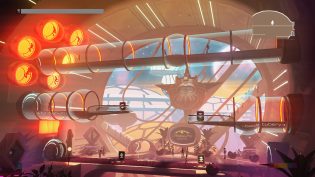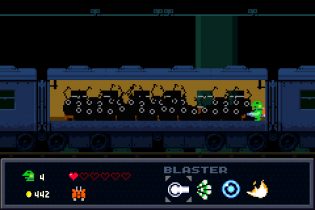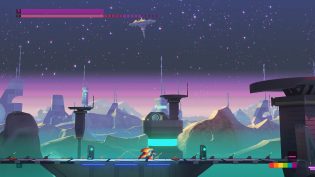When you think Double Fine, you usually think adventure games, either point and click or action adventures. They do have attempts at strategy games and even simple jRPGs, but it still feels a bit weird to see something like Headlander pop up. Because Headlander is a metroidvania… At least, Pixel is consistent in his love of cutely drawn action platformers, even if, unlike Cave Story, Kero Blaster is linear. So, let’s take a quick look at these two games.
The basic gimmick for Headlander is quite unique for a metroidvania, but not unique for Double Fine. The idea is that – your player character is a flying head in a helmet in a 70s inspired sci-fi with groovy robots who’s bodies you can steal by replacing their heads with yours. If you thought Stacking, or even an earlier attempt on the concept during the level in Psychonauts, you also play a lot of Double Fine games. And indeed, there’s a lot of similar ideas here – different bodies you can get have different security clearance, just like a costume in a Hitman game will be, thus removing the need to find keys to open doors – instead you find bodies and ways to get them to where you want. Which is trickier than it may sound, because you can’t jump in Headlander. It’s such a weird thing for a metroidvania, but is tied really well with the overall design of you constantly swapping bodies with your quick and constantly improving head, so after the initial surprise, you get used to it really fast.
Which is not to say all the decisions in Headlander feel justified. While it looks and sound great and the basic setup and controls are surprisingly clever, the game sometimes pushes some ideas a bit too far. One of the earlier major hub areas to explore, for example, feels a bit too convoluted and overwhelming to be fun, even for a person like me who tends to orient themselves in levels easily. There are several frustrating parts focusing on precision shooting, which isn’t particularly precise no matter how hard you try. And the combat in the game tends to be seriously unbalanced with the best ability of the whole game being an unlockable skill of damaging enemies by rolling into them, which you will then abuse until the game ends. Game also suffers from a surprising amount of repetition and feels longer than it should be, despite taking me about 5 hours to 100%. But it’s certainly fun and all the frustrating parts are easy to ignore. It’s just clearly a budget downloadable title and it shows.
Where I had a lot of frustration, but almost never felt like it was game’s fault, is Kero Blaster. I still didn’t finish the game, technically. As with Cave Story, I dropped it at the final boss fight, but that’s more down to me being terrible at action platformers, rather than the fault of the game. And unlike the Cave Story, Kero Blaster doesn’t really have any weird difficulty spikes or other things that I considered genuine bad design. It’s a solid fun little action title, preceded by 2 free side-games Pink Hour and Pink Heaven that serve as demos and are something that I definitely recommend checking out.
In general, it’s a very 8-bit era platformer action at core, with several different upgradable weapons, very limited (but upgradable) health, pretty short, but very varied levels with different gimmicks and a whole new sequel/expansion mode that was added after release and available after you finish the game once, that has a new story, completely redesigned levels, new weapons and is a much much harder game in general. It’s definitely very lovely and definitely worth a check if you have any interest in action platformers and personally I think it’s a superior game to Cave Story.




